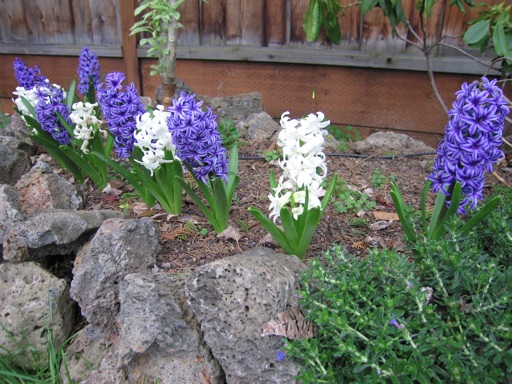
In the fall of 2008, we planted hyacinth bulbs in our yard. Many of those bulbs are blooming for the second time this week. I was surprised to see them bloom a second time with only slightly less vigor than last year, because I have read that we don’t get enough winter chill in our climate to stimulate hyacinths to re-bloom year after year. The hyacinth bulbs I have planted in prior years have tended to come back with less and less vigor each year until they die completely.
Although our hyacinths have been low maintenance flowers otherwise. We get enough rain in the winter months when they are in bloom that we do not need to provide them with supplemental watering. Also, I have not fertilized them.
The blue/purple hyacinth flowers are the most stunning to look at, and this color has re-bloomed the best out of all the hyacinth colors we planted. Although the white hyacinth flowers have by far the best fragrance. We planted more blue/purple and white hyacinth bulbs last fall in different locations (below picture). Those bulbs are a few weeks behind the 2008-09 crop in their bloom cycle.

February 28 2010 | Hyacinths | Comments Off on Hyacinth Re-Bloom


I added a new Arctic Rose nectarine tree to my collection of backyard fruit trees a few weeks ago. The first picture above shows what the tree looked like after I brought it home from the nursery, and the second picture shows how it looked after I pruned it severely, cutting off most of the branches. I have read several resources over the past year about pruning fruit trees. Most of these sources advise home growers to prune fruit trees regularly, especially in the first few years after they are planted when they are still small.
I have always wondered why the branches of many backyard fruit trees bend and break under the weight of the fruit that they bear. Why is it that these trees have not evolved strong enough branches to bear the weight of their fruit? Put another way, why it is that these fruit trees have evolved to bear more fruit than their branches can support the weight of?
The answer is that most of the fruit trees that people grow for food today are not entirely the result of natural selection. Breeders have bred fruit trees such as apples, pears, and peaches to bear large fruits. The wild versions of the fruit trees that we know and love are much more able to support the weight of their fruit, partly because the fruit they bear is much smaller than the cultivated varieties we cherish. For example, today’s large cultivated apples are probably descended from crabapple trees, which produce fruits that are only about 1-2 inches in diameter. Wild peaches trees that grow in their native China produce fruits that are much smaller and more sour that the peaches that are cultivated throughout the world today.
Although fruit tree breeders have been very successful at improving the size and flavor of many modern cultivars of fruit trees, they have not improved the strength of the branches of fruit trees. The only way to do that is to prune often and heavily. Pruning the branches of a tree stimulates the tree to thicken and strengthen the shortened branches that remain, making them much better able to support the weight of a heavy load of large fruits.
I am now pruning my fruit trees 1-3 times a year so that they can support the weight of their fruit without needing supports or causing branch breakage. Depending on how fast an individual tree is growing, I sometimes prune the same tree as often as 3 times per year, in the winter, in the spring, and in the summertime. Many of my fruit trees grow rapidly in the spring after a winter prune. Spring and summer pruning does a good job of reducing the vigorous growth rate of trees. Frequent pruning has kept our fruit trees small so that it is easier to spray them (if needed), net them, harvest the fruit, and perform subsequent pruning.
I have read repeatedly that is especially important to prune peach and nectarine trees heavily, because they grow vigorously and produce many more fruits than they can support. I think that at least 2/3 of the branches of a peach/nectarine tree should be removed each year to control its size and fruit production. If pruning doesn’t do enough to reduce the number of peach or nectarine fruits a tree produces, I will thin the fruits to about 4-6 inches apart in May-June. Thinning the fruit greatly reduces the likelihood of branches breaking. Also, in the years that I thinned my peaches, my O’Henry peach tree has produced peaches that are much larger in size than in the years I have not thinned them.
February 20 2010 | Fruit and Peaches/Nectarines | Comments Off on Severe Pruning of Fruit Trees



